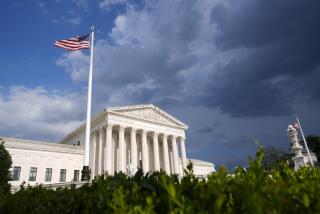Debate on How to Fill Supreme Court Seats
- Share via
California’s $11.4-million judicial election campaign in 1986 has spawned a spirited debate in some legal circles over the need to change the method in which judges are selected and retained.
Among the most discussed proposals are three that would reduce the frequency with which Supreme Court justices appear on the ballot for voter confirmation.
The proposals are not academic because the appearance of a court majority on the election ballot has become a regular occurrence, and in 1990 at least five members of the state’s high court are scheduled to be on the ballot.
One proposal would give a new court appointee a full 12-year term rather than simply the remaining years of a predecessor’s term even after the appointee wins voter confirmation.
The current system is “really a historical anomaly dating back to the era when Supreme Court seats were political plums controlled by the nominating conventions of the political parties,” said Gerald F. Uelmen, dean of the Santa Clara University School of Law.
Another proposal would have justices appear on the ballot for retention at the next statewide general election following their appointment rather than at the next gubernatorial election.
“The sooner a justice appears on the ballot after his or her initial appointment, the greater the likelihood that the contest will be perceived as a confirmation of his or her qualifications rather than a referendum on the popularity of previously rendered decisions,” Uelmen said.
Change in Commission
Perhaps the most controversial of the three would limit the justices to a single, 12-year term, with the possibility of a reappointment by the governor. On the one hand, there is great appeal in the prospect that a judge would serve a long term without having to think about facing a voter referendum. But some fear such a limit might preclude the immense long-term contributions of jurists such as Roger Traynor, who served on the state Supreme Court for 30 years; Phil Gibson, who served 25, and Stanley Mosk, who also is near the quarter-century mark.
Separately, many are talking again about changing the makeup of the three-member Commission on Judicial Appointments, which has the authority to approve or disapprove the judicial nominations of the governor.
The commission, created with the passage of Proposition 3 in 1934, is made up of the chief justice, the attorney general and the senior presiding justice of the Court of Appeal. But many say it is an inherent conflict of interest to have the attorney general, who represents the state before the Supreme Court, voting on a prospective member of that court. Similarly, others have said that it is at best awkward to have a chief justice voting on a prospective colleague on the court.
Some also have proposed enlarging the commission’s membership, but as Sen. Bill Lockyer (D-Hayward) has noted: “ . . . No one has yet been able to figure out who they would trust adding to the commission. . . .” In Sacramento, the state Senate Judiciary Committee has considered abolishing the commission altogether and granting the Senate authority to confirm judicial appointments by a two-thirds vote. But the proposal has not gained wide support.
More to Read
Get the L.A. Times Politics newsletter
Deeply reported insights into legislation, politics and policy from Sacramento, Washington and beyond. In your inbox twice per week.
You may occasionally receive promotional content from the Los Angeles Times.









